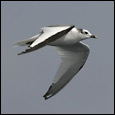
Text by Betsy Hopkins, Senegal Birders Club
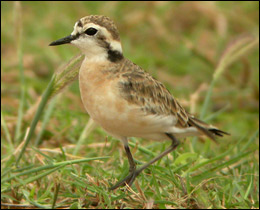 |
| Kittlitz's
Plover at Technopole. Photo: Martin Oomen, 2005 |
As the city, and more recently residential suburbs, have grown up around, and sometimes within, these zones, a few have remained intact – although admittedly, no longer undisturbed. If the Birder can set his sights beyond the all too evident physical disturbances that a city of two million plus inhabitants would be expected to create, a virtual treasure trove of West Africa's avifauna is there for the enjoying! Dakar definitely affords urban birding opportunities at their best.
Dakar – a
good place for microbirding
Upon arrival, be sure to check out your hotel gardens. Many of the hotels
are located along the coast. Beautiful Sunbirds will be flashing by as
they enjoy the tropical foliage, brightly colored Village Weavers may
be nesting in the palm trees around the pool and the alarmed cries of
Spur-winged Plovers will let you know YOU are being carefully watched!
Don't be surprised to hear Rose-ringed Parakeets flying over on a regular
basis and the brilliant yellow and green Senegal Parrots only slightly
less frequently. On the beaches you may see various kinds of Egrets (Little,
Cattle, Intermediate, Great White) and herons (Black, Western Reef, Striated,
Squacco, Grey – and even occasional Purple) as well as both Great
and Long-tailed Cormorants. Depending on the time of year, smaller waders
abound, including Ringed and Little Ringed Plovers and several types of
Sandpipers. Around the port area, you may also see flocks of Pelicans
soaring high.
There
are always Yellow-billed Black Kites enjoying the thermals in the skies
over Dakar. Among the scavengers, Pied Crows and Hooded Vultures are also
numerous in the city.
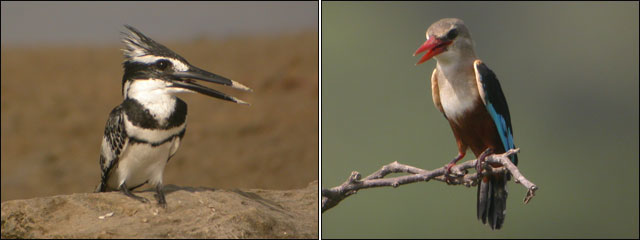 |
| From left: Pied Kingsfisher and Grey-headed Kingsfisher, Technopole. Photos: Johan Stenlund, 2004. |
Senegal boasts in the area of 660 species, 1/3 of which are migrants, mainly Palearctic. The region supports such diversity due to a number of factors. A primary factor which puts it on the map for so many species is its location as a crossroads between the Sahel and drier Sahara region to the north, and the more humid semi-tropical south. This convergence lends itself to presenting numerous habitats. Birds living in everything from desert grasslands to the ocean find a comfortable home in Senegal! Those migrating find welcome green before or after (depending on which direction they are going) the vast expanses of the Sahara. Several large protected areas, including the Parc National de Djoudj on the Senegal River in the north and the Parc National de Niokolo Koba on The Gambia River in the east, as well as the huge area around the Sine-Saloum Delta all also encourage proliferation of both species and numbers of birds. (Information taken from The Birds of the Gambia and Senegal, 1997. Barlow, Wacher and Disley, Sussex: Pica Press. pp 1-7).
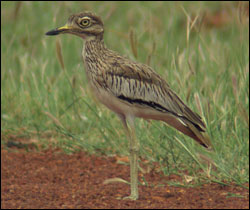 |
| Senegal Thick-knee
at Technopole.. Photo: Björn Johansson, 2005. |
Technopole
– the
"hottest" site in Dakar
When planning your
birding strategy, there is one place you must not miss before you either
go offshore for some pelagic birding, or go into the interior to visit
some of the National Parks. This is the Technopole. This area of 200 hectares
(450 acres) is situated along the north-side of the autoroute leading
off the Cap Vert peninsula (about 20 minutes from Calao with a taxi ride!),
just a few kilometers from center city or from the airport. Set aside
for development as a combined cyber-technical center and an 18-hole golf
resort, it has been protected (unlike surrounding areas) from residential
development. A combined mosaic of drier sandy flats, and extensive reed
marshes surround the golf course area. With an extensive system of diking,
large lakes have been carefully added to the area, attracting in certain
months huge numbers of birds. A summer migration of Black Terns in 2003
was estimated over a period of 3 weeks in the tens of thousands. Depending
on the time of year, hundreds of Greater Flamingos have visited the naturally
salty lakes near the Golf Clubhouse. During a typical morning or late
afternoon visit, up to 50 species can be easily seen in an hour or so.
Birders in the Senegal Birders Club have visited the Technopole regularly
over the past 5 years, keeping a record of what has been seen. Over 150
species have been recorded to date. A visit to the Technopole is an excellent
way to get introduced to many of the common birds you'll see elsewhere
in the country, and also to see at close-range some of the less common
ones you'll want to be looking for.
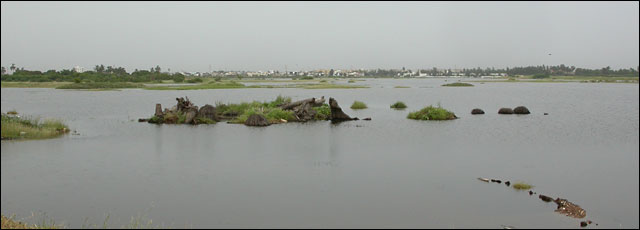 |
| The large wetland area in the western part of Technopole. Photo: Niklas Holmström, October 2005. |
| Checklist
to the birds at Technopole (PDF 26 KB) – Updated
21 October 2005 This list, which contains 153 bird species recorded at Technopole, is compiled by Niklas Holmström with great help from Betsy Hopkins. |
|
| Further
information about birding at Technopole (PDF 15KB) – Updated
23 October 2005 The text is written by Betsy Hopkins, and would be useful for everyone who plan to visit the area! |
|
Please check the Photo Gallery for more views and and bird photos from Technopole!
Copyright © 2004-2012, All rights reserved